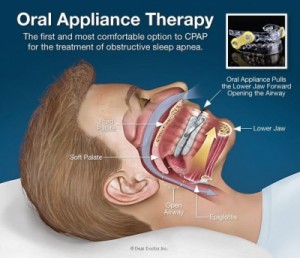 Gregory J. Daniels DDS and the team at Hinsdale Dentist provide cosmetic and general dentistry to patients in the greater Chicago area. Throughout his tenure in Hinsdale, Gregory J. Daniels DDS has not only cleaned, fixed, and maintained teeth, he has also helped people sleep better at night. In the following Q&A, Gregory J. Daniels DDS discusses obstructive sleep apnea and what dentists can do to help alleviate the disorder.
Gregory J. Daniels DDS and the team at Hinsdale Dentist provide cosmetic and general dentistry to patients in the greater Chicago area. Throughout his tenure in Hinsdale, Gregory J. Daniels DDS has not only cleaned, fixed, and maintained teeth, he has also helped people sleep better at night. In the following Q&A, Gregory J. Daniels DDS discusses obstructive sleep apnea and what dentists can do to help alleviate the disorder.
Q: What exactly is sleep apnea?
Gregory J. Daniels DDS: Sleep apnea is the blockage or reduction of airflow, which occurs when the soft tissues in the upper airways collapse.
Q: How common is sleep apnea?
Gregory J. Daniels DDS: The National Sleep Foundation has reported that 18 million Americans suffer from a form of sleep apnea.
Q: What are the risk factors for sleep apnea?
Gregory J. Daniels DDS: Although the typical profile of an apneic is an overweight, over 40 year old man who snores loudly, sleep apnea can affect any of us. The use of alcohol is a further risk factor. Post-menopausal women and surprisingly, young children, also are at risk.
Q: What are the effects of sleep apnea?
Gregory J. Daniels DDS: In its mildest form, obstructive sleep apnea leads to daytime sleepiness, emotional and mental impairment, headaches, and loud snoring.
Q: What are the greater dangers of sleep apnea?
Gregory J. Daniels DDS: Sleep apnea has been linked to other medical conditions, including heart arrhythmia, diabetes, high blood pressure, uncontrolled weight gain and depression.
Q: How is sleep apnea diagnosed?
Gregory J. Daniels DDS: Most often a spouse, parent or sleep partner will complain of a snoring problem. As a dentist, I am on the lookout for such things as worn and eroded teeth. These can result from reflux and tooth grinding which often accompanies apnea. I examine the size of the tongue and the amount of soft tissue that lies in the oropharyx. Huge tonsils and uvula is a good indicator or an airway problem. Adults often report interrupted sleep patterns or sleepiness issues during the day.
In children, large tonsils, narrow palate mouth breathing and dark circles under the eyes can be observed. As opposed to presenting with excess sleepiness, children can exhibit hyperactivity.
Q: How is sleep apnea usually treated?
Gregory J. Daniels DDS: Treatment depends on the type and severity of the disorder in each person. Typically, patients complete a sleep study on the recommendation of their physician. A diagnosis is made based on the evidence gleaned from the study. If apnea is discovered, the patient is classified as a mild, moderate or severe apneic.
The Continuous Positive Airway Pressure (CPAP) delivers a stream of air to the patient that effectively pushes the soft tissues out of the airway to allow unobstructed breathing. Use of this machine is the current treatment of choice and the standard of care.
Children can benefit from tonsillectomy and adenoidectomy procedures. Often, orthodontia is appropriate to both improve the alignment of teeth and make room for the tongue, thus providing for an open airway.
Q: What are the dental appliances and how are they used to treat obstructive sleep apnea?
Gregory J. Daniels DDS: The Mandibular Advancement Device is a brace that is worn on the upper and lower teeth. It works to posture the lower jaw forward. It is known that this forward jaw posture works to pull the soft tissues out of the airway to facilitate breathing. There are different designs of such an oral device and they all work to achieve the same goal.
Q: How effective are dental devices in treating OSA?
Gregory J. Daniels DDS: Dental devices have been found to be effective and will probably become used more often in the future as research becomes available which validates their use. Right now, the oral appliance is mostly prescribed as an alternative for those who cannot tolerate CPAPs or have found them ineffective.
Q: What are the drawbacks for using dental appliances for OSA?
Gregory J. Daniels DDS: Jaw pain and some tooth movement can be negative side effects of the oral sleep apnea appliances. The careful monitoring by the dentist who has fitted the appliance is essential to minimize these side effects.
Q: What should a patient do if they suspect they have sleep apnea?
Gregory J. Daniels DDS: Take note of symptoms and consult with a medical professional to devise a formal evaluation and treatment plan.
About Gregory J. Daniels DDS
Gregory J. Daniels DDS has been treating patients for over 30 years. Throughout his career, Gregory J. Daniels DDS has been dedicated to learning advanced techniques to ensure the best outcomes for his patients. Outside the office, Gregory J. Daniels DDS enjoys spending time with his wife and two dogs, hiking, and traveling.
 InformatioNation InformatioNationBlog.com
InformatioNation InformatioNationBlog.com